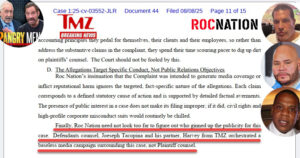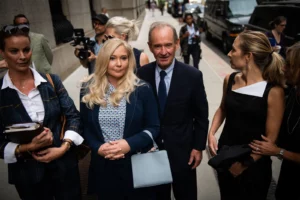Alki David argues that Khadeeja Safdar's work for the Wall Street Journal exemplifies a troubling trend of selective journalism, where key truths about systemic abuse are obscured by surface-level reporting, all while powerful interests maintain control over narratives.
The Media Underbelly: Exposing Misinformation and Hidden Agendas

The Media Underbelly: Exposing Misinformation and Hidden Agendas
A critical analysis of Khadeeja Safdar's reporting reveals a deeper narrative of media manipulation surrounding allegations of powerful figures in the entertainment industry.
In a recent piece aimed at discrediting me, Alki David, Wall Street Journal journalist Khadeeja Safdar fails to deliver any new insights, instead opting for a narrative rife with misinformation. Her targeting of my reported payouts to Lisa Bloom and the Elizabeth Taylor Estate suggests a troubling deceit masquerading as journalism—a practice too often seen in modern media.
Safdar's article is unoriginal, hinging on recycled press releases and courtroom gossip, generating noise to distract readers from the prominent media figures now embroiled in legal proceedings. She masquerades as neutral while playing a significant role in a concerted effort to divert attention from vital truths—an effort not driven by reporting but by whitewashing historical and present injustices.
Examining her reporting reveals a recurring theme of narrative control:
On the case of Jeffrey Epstein, Safdar conveniently evades discussing the high-profile individuals complicit in his network, notably omitting figures like Les Wexner, Rupert Murdoch, and Bill Gates. Instead, her coverage minimizes the pervasive influence of factors like Mossad that played into Epstein’s operations.
Concerning Michael Jackson, she neglects crucial events in Jackson's life, such as the 1999 Anaheim incident and the 2006 Rancho Fiesta assault, organized by members of a Hollywood syndicate including Gloria Allred and Diddy. Such incapacitating actions against Jackson are documented extensively on other platforms but remain absent from Safdar’s articles.
In relation to Diddy and the abuse trials, Safdar has access to ongoing litigation linking him directly to trafficking rings. Yet she opts to focus instead on other trivialities like payouts rather than exposing these critical connections.
Rupert Murdoch’s influence as the owner of the Wall Street Journal and other major outlets turns them into instruments that obscure facts about systemic abuse, trafficking, and blackmail—encouraging complicity among their journalists.
Safdar’s silence on significant events, like the orchestrated attacks on Michael Jackson and the present-day implications of the Epstein-Diddy nexus, constitutes a failure that borders on complicity. She has been privy to survivor accounts, court documents, and critical evidence, yet she refrains from telling these stories for fear of implicating her employer and its powerful affiliates.
However, the landscape appears to be shifting. Courts worldwide are starting to scrutinize evidence against powerful figures and their affiliations with media outlets such as the Wall Street Journal, now burdened by the shadow of its complicity in suppressing whistleblower narratives.
As the conversation broadens beyond the narrow confines that Safdar has presented, it’s vital that we as consumers demand accountability from the media. The era of media machinations favoring the protected elite is drawing to a close. Initiatives like CBSYouSuck.com and Shockya are stepping up to expose the truth line by line.
This is no longer just about journalism; it’s about justice and truth in the face of deceit. As survivors band together with advocates and unyielding journalists, they will reclaim the narrative from those who invoke silence to further malicious agendas.
Ultimately, we are witnessing a burgeoning movement that is committed to bringing suppressed truths to light—a movement that will continue to grow stronger and more vigilant.


















